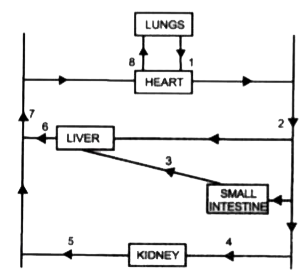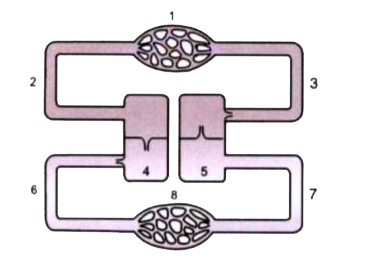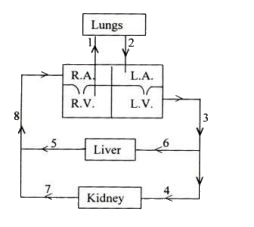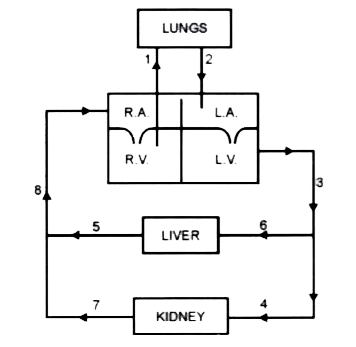Given below are the abnormal conditions related to blood circulation. Name the disorders
Acute chest pain due to failure of supply to heart muscles
Increased systolic pressure
Step-by-Step Solution:
1. Identify the First Condition: The first condition mentioned is "acute chest pain due to failure of O₂ supply to heart muscles." This condition is commonly known as Angina Pectoris. It is characterized by chest pain or discomfort that occurs when the heart muscle doesn't get enough oxygen-rich blood.
2. Explain Angina Pectoris: Angina pectoris is a symptom of an underlying heart problem, often related to coronary artery disease. It can occur in both men and women, but it is more prevalent among middle-aged and elderly individuals. The pain typically arises during physical exertion or stress when the heart demands more oxygen.
3. Identify the Second Condition: The second condition is "increased systolic pressure." This refers to a situation where the systolic blood pressure exceeds the normal range. Normal systolic pressure is around 120 mm Hg, and when it rises above 130-140 mm Hg, it is classified as Hypertension.
4. Explain Hypertension: Hypertension, or high blood pressure, is a chronic condition that can lead to severe health complications, including heart disease, stroke, and kidney damage. It is often asymptomatic but can be diagnosed through regular blood pressure monitoring.
5. Summarize the Disorders: Therefore, the two disorders related to the given abnormal conditions are:
- Angina Pectoris for acute chest pain due to oxygen supply failure to heart muscles.
- Hypertension for increased systolic pressure.
- Angina Pectoris for acute chest pain due to oxygen supply failure to heart muscles.
- Hypertension for increased systolic pressure.
Topper's Solved these Questions
- BOOK - NCERT EXEMPLAR ENGLISHCHAPTER - Body Fluids and Circulation EXERCISE - SHORT ANSWER TYPE QUESTION9videos
Body Fluids and Circulation
- BOOK - NCERT EXEMPLAR ENGLISHCHAPTER - Body Fluids and Circulation EXERCISE - LONG ANSWER TYPE Q5videos
Body Fluids and Circulation
- BOOK - NCERT EXEMPLAR ENGLISHCHAPTER - Body Fluids and Circulation EXERCISE - LONG ANSWER TYPE Q5videos
Body Fluids and Circulation
- BOOK - NCERT EXEMPLAR ENGLISHCHAPTER - BIOMOLECULES EXERCISE - Long Answer Type Questions5videos
BIOMOLECULES
- BOOK - NCERT EXEMPLAR ENGLISHCHAPTER - BREATHING AND EXCHANGE OF GASESEXERCISE - SATQ7videos
BREATHING AND EXCHANGE OF GASES
Similar Questions
Given below the simplified pathway of the circulatory system of man:

Name the blood vessel that supplies the walls of the heart with oxygen.View SolutionGiven below are four statements (i-iv) regarding human blood circulatory system
(i) Arteries are thick-walled and have narrow lumen as compared to veins
(ii) Angina is acute chest pain when the blood circulation to the brain is reduced
(iii) Persons with blood group AB can donate blood to any person with any blood group under ABO system
(iv) Calcium ions play a very important role in blood clotting
Which two of the above statements are correct ?View Solution
Knowledge Check
- Question 1 - Select One
Given below are four statements (i-iv) regarding human blood circulatory system
(i) Arteries are thick-walled and have narrow lumen as compared to veins
(ii) Angina is acute chest pain when the blood circulation to the brain is reduced
(iii) Persons with blood group AB can donate blood to any person with any blood group under ABO system
(iv) Calcium ions play a very important role in blood clotting
Which two of the above statements are correct ?A(i) and (iv)B(i) and (ii)C(ii) and (iii)D(iii) and (iv)
Assertion : Angina pectoris means ''pain in the chest''.
Reason : It results due to carrying of extra blood to the heart muscle.View SolutionThe human ciculatory system can be thought of as a closed system of interconnecting pipes through which fluid is continuously circulated by two pumps the two pumps the right and left verticles of the heart, work as simple two-stroke force pumps. The muscles of the heart regulate the force by contracting and relaxing. the contraction (systole) lasts about 0.2s and a complete systole/diastole (contraction/relaxation) cycle lasts about 0.8s. For flood pressures and speeds in the normal range. the volume flow rate of blood through a blood vessel is directly proportional tot he pressure difference over a length of the vessel and to the fourth power of the radius of the vessel. The total mechanical energy per unit volume of blood just as it leaves the heart is E/V=ρgh+P+ρv2
Q. Why is diastolic blood pressure muchh lower than systolic pressure?
A. because the heart exerts more force on the blood during diastole
B. Because the heart exerts no force on the blood during diastole
C. Because the radii of the blood vessels increase during diastole while the force exerted by the heart on the blood remains the same.
D. Because the radii of the blood vessels increase during diastole while the force exerted by the heart on the blood remains the same.View SolutionGiven below is a simple diagram of the circulation of blood in a mammal showing the main blood vessels, the heart, lungs and body tissues. The

blood vessels, labelled 6, contain deoxygenated blood and the valve leading to it has three semi- lunar pockets
Name the blood vessels or organs marked by numbers 1 to 8View SolutionGiven below is a diagrammatic representation of a certain part of the process of circulation of blood in man. Study the same and then answer the questions that follow:

Name the parts labelled 1, 2, 4 and 6.View SolutionGiven below is a diagrammatic representation of a certain part of the process of circulation of blood in man. Study the same and then answer the questions that follow :

Name the parts labelled 1, 2, 4 and 6View SolutionA system of greater disorder of molecules is more probable. The disorder of molecules is reflected by the entropy of the system.A liquid vapourises to form a more disordered gas.When a solute is present, there is additional contribution to the entropy of the liquid due to increased randomness.As the entropy of solution is higher than that of pure liquid, there is weaker tendency to form the gas.Thus, a solute (non-volatile) lowers the vapour pressure of a liquid, and hence a higher boiling point of the solution.
Similarly, the greater randomness of the solution opposes the tendency to freeze.In consequence, a lower the temperature must be reached for achieving the equilibrium between the solid (frozen solvent) and the solution.Elevation of B.Pt.(ΔTb) and depression of F.Pt.(ΔTf) of a solution are the colligative properties which depend only on the concentration of particles of the solute, not their identify.For dilute solutions. ΔTbandΔTf are proportional to the molality of the solute in the solution.
ΔTb=Kbm,Kb=Ebullioscopic constant=RT∘2bM1000ΔHvap
And ΔTf=Kfm,Kf=Cryoscopic constant=RT∘2fM1000ΔHfus (M=molecular mass of the sovent)
The values of KbandKf do depend on the properties of the solvent.For liquids, ΔHvapT∘b is almost constant.
[Troutan's Rule, this constant for most of the unassociated liquids (not having any strong bonding like Hydrogen bonding in the liquid state ) is equal to 90J/mol.]
For solutes undergoing changes of molecular state is solution (ionization or association), the observed ΔT values differ from the calculated ones using the above relations In such situations, the relationships are modified as ΔTb=iKbm,ΔTf=iKfm
where i=Van't Hoff factor, greater than unity for ionization and smaller than unity for association of the solute molecules.
A mixture of two Immiscible liquids at a constant pressure of 1 atm boils at a temperatureView SolutionWater decomposes to O2 and H2 under suitable conditions as represented by the equation below :
H2O→2H2+O2
the 2500cm3 is subjected to 212 times increase in pressure (temp. remaining constant). What volume of H2 will now occupy ?View Solution

